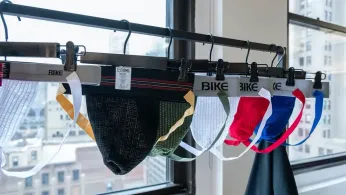
2 hours ago
Jockstraps Go Public: How a Queer Club Staple Became 2025’s Boldest Streetwear Flex
READ TIME: 3 MIN.
At Pride events and club nights this year, the jockstrap is no longer hidden—it’s styled over tights, paired with mesh, layered with harnesses, and treated like any other statement accessory. Designers and DIY makers alike are selling embellished versions, while social media creators document “jock check” fit videos as a tongue-in-cheek riff on streetwear haul culture. The effect is both fashion-forward and culturally loaded: reclaiming a garment once tied to locker-room shame and turning it into a banner for queer pleasure and autonomy. . . .
The jockstrap’s public moment builds on decades of visibility in leather and fetish scenes, where it functioned as practical gear and coded signal. Archival imagery from 1970s leather bars and Folsom Street Fair shows the silhouette normalized in those communities long before mainstream fashion caught on, and it remained a ballroom performance staple through the 1980s and 1990s for its movement and body emphasis. Today, leather events continue to center the garment, reinforcing its roots even as it migrates into broader nightlife. . . .
High-fashion interest has accelerated the trend’s crossover. Recent runway seasons have featured exposed jockstrap waistbands, structured athletic codpieces, and backless trousers that read as jockstrap-adjacent styling—stylistic choices that move the piece from club gear to editorial object. Celebrity stylists have echoed the look on red carpets and tour stages, lending it visibility that filters down to weekend wear. . . .
On menswear runways this year, stylists cited the “athletic intimate” as a design anchor, pairing knit jockstraps with suiting and technical outerwear; the aesthetic blurs sport, fetish, and tailoring into a single silhouette. That framing helped normalize the garment for shoppers who encounter it not as a novelty but as a styled component. . .
On TikTok and Instagram Reels, short styling clips popularized the “strap over tights” and “strap over denim” formulas, often accompanied by educational captions about consent and safe-space dressing. The algorithm favored dance challenges and fit checks that centered the waistband reveal, pushing the look across queer and allied audiences in weeks. Hashtags combining Pride, leather, and athleticwear gathered millions of views during June, demonstrating how platform mechanics can translate niche codes into seasonal staples. . . .
Creators have also used the trend to talk about body diversity and trans-affirming styling, including how to adapt jockstraps with hosiery, compression garments, or layering for comfort. These posts foreground fit, fabric, and function as much as aesthetics, broadening who sees themselves in the look. . .
As the jockstrap enters public space, debates over dress codes have followed. Some Pride organizers issued updated guidance this summer—framed around local ordinances and family-friendly zones—while affirming that fetishwear remains welcome in designated areas. These guidelines attempt to balance expressive freedom with city permitting, and they underscore how fashion can quickly become a policy question. . .
Queer nightlife venues have simultaneously reinforced consent norms with signage and door briefings, reminding attendees to ask before touching and to respect photography policies—important as more patrons arrive intending to shoot content. This community-led etiquette predates the current trend but has taken on renewed urgency as intimate garments become highly visible. . .
Several converging forces explain the jockstrap’s moment. First, a wider post-pandemic comfort with loungewear-to-streetwear pipelines made intimate garments in public feel less transgressive. Second, a backlash to rainbow capitalism pushed many attendees to foreground silhouettes and materials coded within queer subcultures rather than generic merch. Third, designers have explicitly cited queer archives, treating the jockstrap as a historical reference point rather than a gimmick. Together, these factors reframe the piece as both a memory object and a forward-looking uniform. . . .
For many, the look is about joy and reclamation. Transgender people, nonbinary people, and cisgender gay and bisexual men have described the trend as a way to center pleasure, own athletic or erotic aesthetics on their own terms, and make the politics of the body visible without apology. The symbolism resonates across identities: what once signaled exclusion now reads as radical welcome. . .
Whether jockstrap styling settles into a lasting wardrobe element or recedes to nightlife will depend on retail adoption and ongoing conversations about public space. Some labels are already offering size-inclusive, adjustable versions in technical fabrics that wash and wear like performance gear—signs of a longer tail. But even if the silhouette shifts, the cultural move it represents—a confident, community-rooted insistence that queer bodies belong in public—will likely endure. . .






